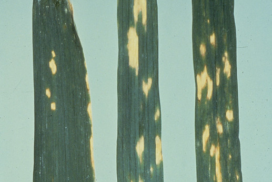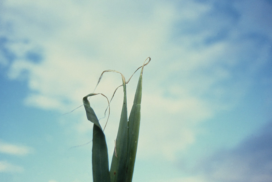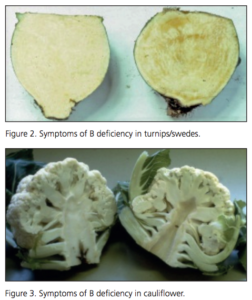Best Use of Limited Supplies: Micro-nutrients
Use of micro nutrients
Manganese (Mn)
- Manganese deficiency symptoms are often transient but usually seen at high soil pH, especially on dry sandy soils, soft seedbeds and/or immediately after liming.
- Soil analysis to predict deficiency is not reliable.
- Deficiency is more likely below 20 mg Mn/kg in leaf analysis.
- Manganese application as a foliar spray is beneficial where symptoms occur or are thought likely.
Copper (Cu)
- Soils most at risk of Cu deficiency leached sandy soils and organic and peat soils.
- Leaf analysis is less reliable than soil analysis for diagnosing deficiencies.
- If possible, treat deficiencies with a soil-applied fertiliser prior to planting with a dressing of 5-10 kg/ha copper oxychloride (52% Cu), or 10-20 kg/ha copper sulphate (25%), depending on the extractable Cu status of the soil, applied on stubble or ploughing.
- Deficiencies can be treated using a foliar spray of copper oxychloride at 0.5-1.0 kg/ha, depending on severity of deficiency, plus wetter in at least 150 litres water once there is enough leaf canopy; or
- chelated Cu products most commonly based on EDTA (typically around 9% Cu w/v) applied at about 70 g Cu per ha, although phenolic acid and lignosulphonate chelates are also available; or
- proprietary Cu products and “Cocktail” foliar feeds as an alternative.
Boron (B)
- Some root crops, especially carrots, fodder beet, beetroot, swedes and turnips are particularly prone to B deficiency, especially where soil pH values are high, and/or on light sandy soil, but the sea is the main source for B in coastal areas.
- Cauliflowers and other brassicas can also be affected, although care must be taken to determine the true cause of symptoms, which can be caused by other factors such as bacterial disease, or uneven water supply.
- Deficiency is more likely below 20 mg B/kg in leaf analysis. Where soil or leaf analysis indicates a deficiency, or for susceptible crops, apply B to the seedbed (2 kg/ha B) or as a foliar spray according to manufacturer’s recommendations as soon as leaf cover allows.
- It is usually enough to apply B once during a rotation, though if root crops, brassicas or carrots are being grown, it is advisable to apply B prior to each of these crops, regardless of whether B has already been applied in the rotation.
- It is not advisable to over-apply B, since B toxicity can cause problems in some crops.
Dr Alex H Sinclair for the Farm Advisory Service

Manganese deficiency in wheat
Photo credit: CIMMYT (CC-BY-NC-SA-2.0)

Copper deficiency in wheat Photo credit CIMMYT (CC BY-NC-SA 2.0)

Sign up to the FAS newsletter
Receive updates on news, events and publications from Scotland’s Farm Advisory Service
